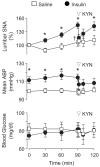Glutamatergic receptor activation in the rostral ventrolateral medulla mediates the sympathoexcitatory response to hyperinsulinemia
- PMID: 20065145
- PMCID: PMC2861553
- DOI: 10.1161/HYPERTENSIONAHA.109.146605
Glutamatergic receptor activation in the rostral ventrolateral medulla mediates the sympathoexcitatory response to hyperinsulinemia
Abstract
Hyperinsulinemia increases sympathetic nerve activity (SNA) and has been linked to cardiovascular morbidity in obesity. The rostral ventrolateral medulla (RVLM) plays a key role in the regulation of SNA and arterial blood pressure (ABP). Many sympathoexcitatory responses are mediated by glutamatergic receptor activation within the RVLM, and both the central renin-angiotensin and melanocortin systems are implicated in the sympathoexcitatory response to hyperinsulinemia. Therefore, we hypothesized that one or more of these neurotransmitters in the RVLM mediate the sympathoexcitatory response to insulin. Hyperinsulinemic-euglycemic clamps were performed in alpha-chloralose anesthetized, male Sprague-Dawley rats by infusion of insulin (3.75 mU/kg per minute, IV) and 50% dextrose solution for 120 minutes. Physiological increases in plasma insulin elevated lumbar SNA, with no change in renal SNA, ABP, or blood glucose. Microinjection of the ionotropic glutamate receptor antagonist kynurenic acid into the RVLM significantly reduced lumbar SNA and ABP. Selective blockade of NMDA but not non-NMDA glutamate receptors resulted in similar reductions of lumbar SNA. In marked contrast, microinjection of the angiotensin II type 1 receptor antagonist losartan or the melanocortin 3/4 antagonist SHU9119 had no effect on lumbar SNA or ABP. Western blot analysis showed that insulin receptor expression is significantly lower in the RVLM than the hypothalamus, and direct microinjection of insulin into the RVLM did not significantly increase lumbar SNA. These findings suggest that hyperinsulinemia increases lumbar SNA by activation of a glutamatergic NMDA-dependent projection to the RVLM.
Conflict of interest statement
Disclosures: None.
Figures






Similar articles
-
Excess dietary salt alters angiotensinergic regulation of neurons in the rostral ventrolateral medulla.Hypertension. 2008 Nov;52(5):932-7. doi: 10.1161/HYPERTENSIONAHA.108.118935. Epub 2008 Sep 8. Hypertension. 2008. PMID: 18779436 Free PMC article.
-
Sympathetic response to insulin is mediated by melanocortin 3/4 receptors in the hypothalamic paraventricular nucleus.Hypertension. 2011 Mar;57(3):435-41. doi: 10.1161/HYPERTENSIONAHA.110.160671. Epub 2011 Jan 24. Hypertension. 2011. PMID: 21263116 Free PMC article.
-
Cerebrospinal Fluid Hypernatremia Elevates Sympathetic Nerve Activity and Blood Pressure via the Rostral Ventrolateral Medulla.Hypertension. 2015 Dec;66(6):1184-90. doi: 10.1161/HYPERTENSIONAHA.115.05936. Epub 2015 Sep 28. Hypertension. 2015. PMID: 26416846 Free PMC article.
-
Glutamate receptors in the hypothalamic paraventricular nucleus contribute to insulin-induced sympathoexcitation.J Neurophysiol. 2015 Mar 1;113(5):1302-9. doi: 10.1152/jn.00764.2014. Epub 2014 Dec 4. J Neurophysiol. 2015. PMID: 25475355 Free PMC article.
-
Central angiotensin modulation of baroreflex control of renal sympathetic nerve activity in the rat: influence of dietary sodium.Acta Physiol Scand. 2003 Mar;177(3):285-9. doi: 10.1046/j.1365-201X.2003.01074.x. Acta Physiol Scand. 2003. PMID: 12608998 Review.
Cited by
-
Central actions of insulin during pregnancy and lactation.J Neuroendocrinol. 2021 Apr;33(4):e12946. doi: 10.1111/jne.12946. Epub 2021 Mar 12. J Neuroendocrinol. 2021. PMID: 33710714 Free PMC article. Review.
-
Ser/thr phosphatases tonically attenuate the ERK-dependent pressor effect of ethanol in the rostral ventrolateral medulla in normotensive rats.Brain Res. 2014 Aug 19;1577:21-8. doi: 10.1016/j.brainres.2014.06.026. Epub 2014 Jun 28. Brain Res. 2014. PMID: 24978604 Free PMC article.
-
Taurine Supplementation Reduces Renal Nerve Activity in Male Rats in which Renal Nerve Activity was Increased by a High Sugar Diet.Adv Exp Med Biol. 2017;975 Pt 1:27-37. doi: 10.1007/978-94-024-1079-2_3. Adv Exp Med Biol. 2017. PMID: 28849441
-
Role of the Paraventricular Nucleus of the Hypothalamus in the Sympathoexcitatory Effects of Leptin.Hypertension. 2015 Nov;66(5):1034-41. doi: 10.1161/HYPERTENSIONAHA.115.06017. Epub 2015 Sep 14. Hypertension. 2015. PMID: 26370892 Free PMC article.
-
Arcuate nucleus injection of an anti-insulin affibody prevents the sympathetic response to insulin.Am J Physiol Heart Circ Physiol. 2013 Jun 1;304(11):H1538-46. doi: 10.1152/ajpheart.00081.2013. Epub 2013 Mar 29. Am J Physiol Heart Circ Physiol. 2013. PMID: 23542919 Free PMC article.
References
-
- Esler M, Straznicky N, Eikelis N, Masuo K, Lambert G, Lambert E. Mechanisms of sympathetic activation in obesity-related hypertension. Hypertension. 2006;48:787–796. - PubMed
-
- Wofford MR, Hall JE. Pathophysiology and treatment of obesity hypertension. Curr Pharm Des. 2004;10:3621–3637. - PubMed
-
- Rumantir MS, Vaz M, Jennings GL, Collier G, Kaye DM, Seals DR, Wiesner GH, Brunner-La Rocca HP, Esler MD. Neural mechanisms in human obesity-related hypertension. J Hypertens. 1999;17:1125–1133. - PubMed
-
- Vaz M, Jennings G, Turner A, Cox H, Lambert G, Esler M. Regional sympathetic nervous activity and oxygen consumption in obese normotensive human subjects. Circulation. 1997;96:3423–3429. - PubMed
-
- Alvarez GE, Beske SD, Ballard TP, Davy KP. Sympathetic neural activation in visceral obesity. Circulation. 2002;106:2533–2536. - PubMed
Publication types
MeSH terms
Substances
Grants and funding
LinkOut - more resources
Full Text Sources
Other Literature Sources
Medical
Research Materials

